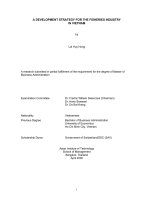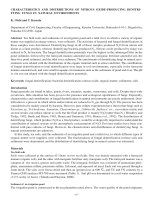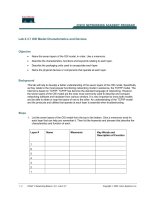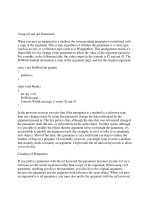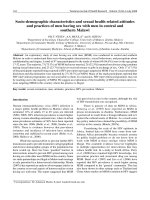Constellation Characteristics and Orbital Parameters
Bạn đang xem bản rút gọn của tài liệu. Xem và tải ngay bản đầy đủ của tài liệu tại đây (267.15 KB, 32 trang )
3
Constellation Characteristics and
Orbital Parameters
3.1 Satellite Motion
3.1.1 Historical Context
In 1543, the Polish Canon Nicolas Copernicus wrote a book called On the Revolutions of the
Heavenly Spheres, which for the first time placed the Sun, rather than the Earth, as the centre
of the Universe. According to Copernicus, the Earth and other planets rotated around the Sun
in circular orbits. This was the first significant advancement in astronomy since the Alexan-
drian astronomer Ptolemy in his publication Almagest put forward the geocentric universe
sometime during the period 100–170 AD. Ptolemy theorised that the five known planets at the
time, together with the Sun and Moon, orbited the Earth.
From more than 20 years of observational data obtained by the astronomer Tycho Brahe,
Johannes Kepler discovered a minor discrepancy between the observed position of the planet
Mars and that predicted using Copernicus’ model. Kepler went on to prove that planets orbit
the Sun in elliptical rather than circular orbits. This was summarised in Kepler’s three
planetary laws of motion. The first two of these laws were published in his book New
Astronomy in 1609 and the third law in the book Harmony of the World a decade later in 1619.
Kepler’s three laws are as follows, with their applicability to describe a satellite orbiting
around the Earth highlighted in brackets.
†
First law: the orbit of a planet (satellite) follows an elliptical trajectory, with the Sun
(gravitational centre of the Earth) at one of its foci.
†
Second law: the radius vector joining the planet (satellite) and the Sun (centre of the Earth)
sweeps out equal areas in equal periods of time.
†
Third law: the square of the orbital period of a planet (satellite) is proportional to the cube
of the semi-major axis of the ellipse.
While Kepler’s laws were based on observational records, it was sometime before these
laws would be derived mathematically. In 1687, Sir Isaac Newton published his breakthrough
work Principia Mathematica in which he formulated the Three Laws of Motion:
Law I: every body continues in its state of rest or uniform motion in a straight line, unless
impressed forces act upon it.
Mobile Satellite Communication Networks. Ray E. Sheriff and Y. Fun Hu
Copyright q 2001 John Wiley & Sons Ltd
ISBNs: 0-471-72047-X (Hardback); 0-470-845562 (Electronic)
Law II: the change of momentum per unit time is proportional to the impressed force and
takes place in the direction of the straight line along which the force acts.
Law III: to every action, there is always an equal and opposite reaction.
Newton’s first law expresses the idea of inertia.
The mathematical description of the second law is as follows:
F ¼ m
d
2
r
dt
2
¼ m
r ð3:1Þ
where F is the vector sum of all forces acting on the mass m; r
¨
is the vector acceleration of the
mass.
In addition to the Three Laws of Motion, Newton stated the ‘‘ two-body problem’’ and
formulated the Law of Universal Gravitation:
F ¼ Gm
1
m
2
1
r
2
r
r
ð3:2Þ
where F is the vector force on mass m
1
due to m
2
in the direction from m
1
to m
2
; G ¼ 6.672 £
10
211
Nm/kg
2
is the Universal Gravitational Constant; r is the distance between the two
bodies; r/r is the unit vector from m
1
to m
2
.
The Law of Universal Gravitation states that the force of attraction of any two bodies is
proportional to the product of their masses and inversely proportional to the square of the
distance between them. The solution to the two-body problem together with Newton’s Three
Laws of Motion are used to provide a first approximation of the satellite orbital motion
around the Earth and to prove the validity of Kepler’s three laws.
3.1.2 Equation of Satellite Orbit – Proof of Kepler’s First Law
The solution to the two-body problem is obtained by combining equations (3.1) and (3.2). In
the formulation, the centre of the Earth is the origin in the co-ordinate system and the radius
vector r is defined as positive in the direction away from the origin. Re-expressing equations
(3.1) and (3.2) to describe the force acting on the satellite of mass m due to the mass of the
Earth, M:
F
m
¼ 2GmM
r
r
3
¼ 2m
m
r
r
3
ð3:3Þ
where
m
¼ GM ¼ 3.9861352 £ 10
5
km
3
/s
2
is Kepler’s constant.
The negative sign in equation (3.3) indicates that the force is acting towards the origin.
Equation (3.1) and (3.3) gives rise to:
d
2
r
dt
2
¼ 2
m
r
r
3
ð3:4Þ
The above equation represents the Law of Conservation of Energy [BAT-71].
Cross multiplying equation (3.4) with r:
r £
d
2
r
dt
2
¼ 2
m
r £
r
r
3
ð3:5Þ
Mobile Satellite Communication Networks84
Since the cross product of any vector with itself is zero, i.e. r £ r ¼ 0, hence:
r £
d
2
r
dt
2
¼ 0 ð3:6Þ
Consider the following equation:
d
dt
r £
dr
dt
¼
dr
dt
£
dr
dt
1 r £
d
2
r
dt
2
ð3:7Þ
From equation (3.6) and from the definition of vector cross product, the two terms on the
right hand side of equation (3.7) are both equal to zero. It follows that:
d
dt
r £
dr
dt
¼ 0 ð3:8Þ
Hence,
r £
dr
dt
¼ h ð3:9Þ
where h is a constant vector and is referred to as the orbital areal velocity of the satellite.
Cross multiplying equation (3.4) by h and making use of equation (3.9):
d
2
r
dt
2
£ h ¼ 2
m
r
3
r £ h ¼
m
r
3
r £ r £
dr
dt
ð3:10Þ
By making use of the rule for vector triple product: a £ (b £ c) ¼ (a·c)b 2 (a·b)c, the
rightmost term of equation (3.10) can be expressed as:
m
r
3
r £ r £
dr
dt
¼ 2
m
r
3
r·
dr
dt
r 2 ðr·rÞ
dr
dt
ð3:11Þ
Since
r·
dr
dt
¼ 0
this implies
m
r
3
r £ r £
dr
dt
¼
m
d
dt
r
r
ð3:12Þ
Comparing (3.10) with (3.12) gives:
d
2
r
dt
2
£ h ¼
m
d
dt
r
r
ð3:13Þ
Integrating (3.13) with respect to t:
dr
dt
£ h ¼
m
r
r
1 c ð3:14Þ
Taking the dot product of (3.14) with r gives:
Constellation Characteristics and Orbital Parameters 85
r·
dr
dt
£ h
¼ r·
m
r
r
1 c
ð3:15Þ
By making use of the rule for scalar triple product, equation (3.15) becomes:
h· r £
dr
dt
¼
m
r
r·r 1 c·r ð3:16Þ
Substituting (3.9) into (3.16) gives
h
2
¼
m
r 1 rc cos
q
ð3:17Þ
where
q
is the angle between vectors c and r and is referred to as the true anomaly in the
satellite orbital plane.
By expressing:
c ¼
m
e ð3:18Þ
Hence:
r ¼
h
2
=
m
1 1 ecos
q
ð3:19Þ
Equation (3.19) is the general polar equation for a conic section with focus at the origin.
For 0 # e , 1, the equation describes an ellipse and the semi-latus rectum, p, is given by:
p ¼
h
2
m
¼ að1 2 e
2
Þð3:20Þ
where a and e are the semi-major axis and the eccentricity of the ellipse, respectively.
This proves Kepler’s first law. Figure 3.1 shows the satellite orbital plane.
3.1.3. Satellite Swept Area per Unit Time – Proof of Kepler’s Second Law
Referring to Figure 3.2, a satellite moves from M to N in time Dt, the area swept by the
position vector r is approximately equal to half of the parallelogram with sides r and Dr, i.e.
DA ¼
1
2
r £ Dr ð3:21Þ
Then the approximate area swept out by the radius vector per unit time is given by:
DA
Dt
¼
1
2
r £
Dr
Dt
ð3:22Þ
Hence, the instantaneous time rate of change in area is:
dA
dt
¼ lim
Dt!0
1
2
r £
Dr
Dt
¼
1
2
r £
dr
dt
ð3:23Þ
Substituting equation (3.9) into (3.23) gives:
dA
dt
¼
h
2
ð3:24Þ
Mobile Satellite Communication Networks86
Since h is a constant vector, it follows that the satellite sweeps out equal areas in equal
periods of time. This proves Kepler’s second law.
3.1.4 The Orbital Period – Proof of Kepler’s Third Law
From equation (3.20),
h ¼
ffiffiffiffiffiffiffiffiffiffiffiffiffiffi
m
að1 2 e
2
Þ
q
ð3:25Þ
Constellation Characteristics and Orbital Parameters 87
Figure 3.1 Satellite orbital plane.
Figure 3.2 Area swept by the radius vector per unit time.
At the perigee and apogee,
r
p
v
p
¼ r
a
v
a
¼ h ð3:26Þ
where v
p
and v
a
are the velocities of the satellite at the perigee and the apogee, respectively.
Integrating (3.25) with respect to t from t ¼ 0tot ¼ t
1
gives:
A ¼ t
1
ffiffiffiffiffiffiffiffiffiffiffiffiffiffi
m
að1 2 e
2
Þ
q
ð3:27Þ
When t is equal to T, where T is the orbital period, then:
A ¼
p
ab ð3:28Þ
where b ¼ a(1 2 e
2
)
1/2
is the semi-minor axis.
Equating (3.27) with (3.28) when t is equal to T, it follows that:
T ¼ 2
p
ffiffiffiffi
a
3
m
s
ð3:29Þ
This proves Kepler’s Third Law.
3.1.5 Satellite Velocity
Using the Law of Conservation of Energy in equation (3.4) and taking its dot product with v,
where v is the satellite velocity, gives:
d
2
r
dt
2
·
n
¼ 2
m
r
r
3
·
n
ð3:30Þ
From equation (3.30):
dv
dt
·v ¼ 2
m
r
3
r·
dr
dt
ð3:31Þ
For any two vectors a and b
d
dt
a·bðÞ¼a·
db
dt
1
da
dt
·b
It follows that
dðv·vÞ
dt
¼
dv
2
dt
¼ 2
dv
dt
·v ð3:32Þ
and
dr
2
dt
¼ 2r·
dr
dt
ð3:33Þ
Substituting (3.32) and (3.33) into (3.31) gives:
1
2
dv
2
dt
¼ 2
m
2r
3
dr
2
dt
ð3:34Þ
Mobile Satellite Communication Networks88
Integrating (3.34) with respect to t:
1
2
n
2
¼
m
r
1 k ð3:35Þ
where k is a constant.
From equation (3.26) and evaluating k at the perigee gives
k ¼
1
2
n
2
p
2
m
r
p
¼
1
2
h
r
p
!
2
2
m
r
p
¼
1
2
m
að1 2 e
2
Þ
a
2
ð1 2 e
2
Þ
2
m
að1 2 eÞ
¼ 2
m
2a
ð3:36Þ
Hence
1
2
n
2
2
m
r
¼ 2
m
2a
ð3:37Þ
It follows that
n
2
¼
m
2
r
2
1
a
ð3:38Þ
It follows from Figure 3.1 that the respective velocities, v
p
and v
a
at the perigee and apogee
are:
n
p
¼
ffiffiffiffiffiffiffiffiffiffiffiffiffiffiffiffiffiffi
m
a
að1 1 eÞ
að1 2 eÞ
s
¼
ffiffiffiffiffiffi
m
r
a
ar
p
s
ð3:39Þ
n
a
¼
ffiffiffiffiffiffiffiffiffiffiffiffiffiffiffiffiffiffi
m
a
að1 2 eÞ
að1 1 eÞ
s
¼
ffiffiffiffiffiffi
m
r
p
ar
a
s
ð3:40Þ
where r
a
¼ a(1 1 e) is the apogee radius and r
p
¼ a(1 2 e) is the perigee radius.
3.2 Satellite Location
3.2.1 Overview
In order to design a satellite constellation for world-wide or partial coverage, a satellite’s
location in the sky has to be determined. A satellite’s position can be identified with different
co-ordinate systems, the choice being dependent upon the type of application. For example,
radio communication engineers prefer to use look angles, specified in terms of azimuth and
elevation, for antenna pointing exercises. The most commonly used co-ordinate systems are
described in the following sections.
Constellation Characteristics and Orbital Parameters 89
3.2.2 Satellite Parameters
A set of six orbital parameters is used to fully describe the position of a satellite in a point in
space at any given time:
V
: the right ascension of ascending node, the angle in the equatorial plane measured
counter-clockwise from the direction of the vernal equinox direction to that of the
ascending node;
i: inclination angle of the orbital plane measured between the equatorial plane and the
plane of the orbit;
v
: argument of the perigee, the angle between the direction of ascending node and
direction of the perigee;
e: eccentricity (0 # e , 1);
a: semi-major axis of the elliptical orbit;
q
: true anomaly.
The first three parameters,
V
, i and
v
define the orientation of the orbital plane. They are
used to locate the satellite with respect to the rotating Earth. The latter three parameters e, a
and
n
define the orbital geometrical shape and satellite motion; they are used to locate the
satellite in the orbital plane. Figure 3.3 shows the orbital parameters with respect to the
Earth’s equatorial plane. The co-ordinate system is called the geocentric-equatorial co-ordi-
nate system, which is used to locate the satellite with respect to the Earth. In this co-ordinate
system, the centre of the Earth is the origin, O, and the xy-plane coincides with the equatorial
plane. The z-axis coincides with the Earth’s axis of rotation and points in the direction of the
North Pole, while the x-axis points to the direction of the vernal equinox. The points at which
Mobile Satellite Communication Networks90
Figure 3.3 Satellite parameters in the geocentric-equatorial co-ordinate system.
the satellite moves upward and downward through the equatorial plane are called ascending
node and descending node, respectively.
In addition to defining the location of a satellite in space, it is important to determine the
direction at which an Earth station’s antenna should point to the satellite in order to commu-
nicate with it. This direction is defined by the look angles – the elevation and azimuth angles –
in relation to the latitude and the longitude of the Earth station. The following sections discuss
the location of the satellite with respect to the different co-ordinate systems. Note: the
formulation of the satellite location outlined in the following sections assumes that the
Earth is a perfect sphere.
3.2.3 Satellite Location in the Orbital Plane
The location of a satellite in its orbit at any time t is determined by its true anomaly,
q
,as
shown in Figure 3.4. In the figure, the orbit is circumscribed by a circle of radius equal to the
semi-major axis, a, of the orbit. O is the centre of the Earth and is the origin of the co-ordinate
system. C is the centre of the elliptical orbit and the centre of the circumscribed circle. E is the
eccentric anomaly.
Refer back to Figure 3.1 and consider the quadrant containing the points P, B, O, C and D
as shown in Figure 3.4. In order to locate a satellite’s position at any time t, the angular
velocity,
4
, and the mean anomaly, M, have to be found. By using the perigee as the
reference point, the mean anomaly is defined as the arc length (in radians) that a satellite
would have traversed at time t after passing through the perigee at time t
0
had it proceeded
on the circumscribed circle with the same angular velocity. The angular velocity is obtained
from (3.29) and is given by:
4
¼
2
p
T
¼
ffiffiffiffi
m
a
3
r
ð3:41Þ
Referring to Kepler’s Third Law, the area swept out by the radius vector at time t after the
Constellation Characteristics and Orbital Parameters 91
Figure 3.4 Satellite location with respect to an orbital plane co-ordinate system.
satellite moves through the perigee at time t
0
is given by:
d
A ¼ A
t 2 t
0
T
ð3:42Þ
Substituting (3.41) into (3.42):
d
A ¼ A
4
ðt 2 t
0
Þ
2
p
¼ A
M
2
p
ð3:43Þ
From equation (3.43)
M ¼
4
ðt 2 t
0
Þð3:44Þ
From Figure 3.4, it can be seen that the area (CPD) is equal to (a
2
E/2) and area (CDB) is
equal to (a
2
cosEsinE/2), this implies:
Area ðDBPÞ¼a
2
½E 2 cosEsinE=2 ð3:45Þ
Since DB=QB ¼ b=a
then Area ðQBPÞ¼ ðb=aÞArea ðDBPÞ¼ab½E 2 cosEsinE=2
and Area ðOQBÞ¼ðOBÞðQBÞ=2 ¼ðacosE 2 aeÞðbsinEÞ=2 ¼ absinEðcosE 2 eÞ=2
Therefore
Area ðOQPÞ¼Area ðOQBÞ 1 AreaðQBPÞ¼
ab
2
E 2 esinE
½
¼
d
A ð3:46Þ
Equating (3.43) and (3.46) gives:
M ¼ E 2 esinE ð3:47Þ
Equation (3.47) is known as Kepler’s equation. In order to find E from (3.47), a numerical
approximation method has to be used. Referring to Figure 3.4,
QB ¼ rsin
q
¼ðb=aÞðasinEÞ
¼ bsinE
¼ að1 2 e
2
Þ
1=2
sinE ð3:48Þ
and
OB ¼ rcos
q
¼ acosE 2 ae ð3:49Þ
Adding QB
2
and OB
2
from equations (3.48) and (3.49) gives:
r ¼
ffiffiffiffiffiffiffiffiffiffiffiffiffiffiffiffiffiffiffi
a
2
ð1 2 ecosEÞ
2
q
ð3:50Þ
and
q
¼ 2tan
21
1 1 e
1 2 e
1=2
tan
E
2
"#
ð3:51Þ
Mobile Satellite Communication Networks92
The location of the satellite in the orbital plane is then given as:
x
0
y
0
z
0
2
6
6
4
3
7
7
5
¼
rcos
q
rsin
q
0
2
6
6
4
3
7
7
5
ð3:52Þ
3.2.4 Satellite Location with Respect to the Rotating Earth
Given the three orbital parameters,
V
, i, and
v
, as shown in Figure 3.3, the location of the
satellite in the geocentric-equatorial system in terms of the orbital plane –ordinates system is
given by [PRA-86]:
x
f
y
f
z
f
2
6
6
4
3
7
7
5
¼
cos
V
cos
v
2 sin
V
cosisin
v
2cos
V
sin
v
2 sin
V
cosicos
v
sin
V
sini
sin
V
cos
v
1 cos
V
cosisin
v
2sin
V
sin
v
1 sin
V
cosicos
v
2cos
V
sini
sinisin
v
sinicos
v
cosi
2
6
6
4
3
7
7
5
x
0
y
0
z
0
2
6
6
4
3
7
7
5
ð3:53Þ
where the first matrix on the right hand side of equation (3.53) is called the rotation matrix.
The geocentric-equatorial co-ordinate system (x
f
, y
f
, z
f
) represents a fixed Earth system. In
order to account for the rotation of the Earth, a transformation of co-ordinates from the fixed
Earth system to a rotating Earth system is required. The relationship between the rotating
Earth system and the geocentric-equatorial system is shown in Figure 3.5.
In this figure, the Earth is rotating at an angular velocity
4
e
.IfT
e
is the elapsed time since
the x
f
-axis and the x
r
-axis last coincided, then the location of the satellite in the rotating Earth
system is related to the geocentric-equatorial system as follows [NAS-63]:
x
r
y
r
z
r
2
6
6
4
3
7
7
5
¼
cos
4
e
T
e
sin
4
e
T
e
0
2sin
4
e
T
e
cos
4
e
T
e
0
001
2
6
6
4
3
7
7
5
x
f
y
f
z
f
2
6
6
4
3
7
7
5
ð3:54Þ
The value of
4
e
T
e
at any time t in minutes is given by:
4
e
T
e
¼
a
g;o
1 0:25068447t ðdegreesÞð3:55Þ
where
a
g,o
¼ 99.6909833 1 36000.7689
t
1 0.00038707
t
2
(degrees);
t
¼ (JD 2 2415020)/
36525 (Julian centuries); JD ¼ 2415020 1 (Y 2 1899) £ 365 1 Int[(Y 2 1899)/4] 1 M
m
1
(D
m
2 D) 1 [(h 2 12)]/24.
JD is the Julian date in year Y, on day D of month m and at h hours (using pm/am
convention). JD is calculated using the reference Julian Day 2415020, which is at noon on
December 31, 1899. M
m
is the number of days between month m and December, the value of
which for different m is tabulated in Table 3.1. D
m
is the number of days in month m. In the
case of a leap year, D
m
¼ 29 in February.
a
g,o
is the right ascension of the Greenwich
meridian at 0 h UT at Julian date JD.
t
is the elapsed time in Julian centuries between 0 h
UT on Julian day JD and noon UT on January 1, 1900.
Constellation Characteristics and Orbital Parameters 93
3.2.5 Satellite Location with Respect to the Celestial Sphere
Refer to Figure 3.6 and consider the location of a satellite in its celestial sphere. The position
of the satellite can be located by its right ascension angle,
a
, and its declination angle,
d
,on
the celestial. From the spherical triangle ASN and using the law of sines,
Mobile Satellite Communication Networks94
Figure 3.5 The rotating Earth system with respect to the fixed Earth system [PRI-93].
Table 3.1 Value of M
m
for Julian dates calcula-
tion
Month M
m
January 334 (335 if it is a leap year)
February 306
March 275
April 245
May 214
June 184
July 153
August 122
September 92
October 61
November 31
December 0

